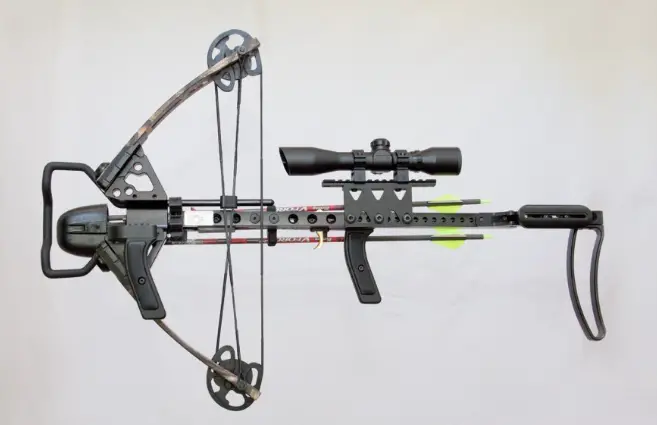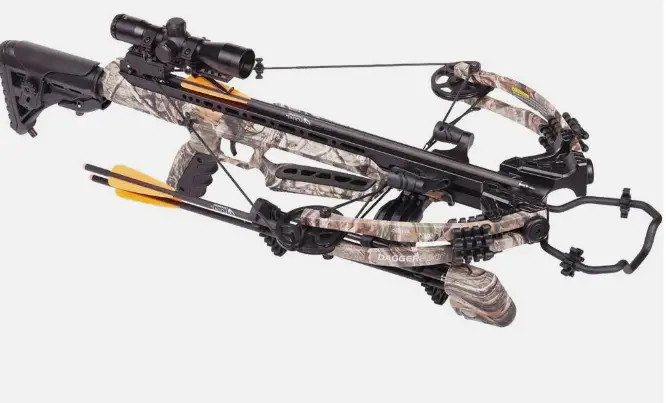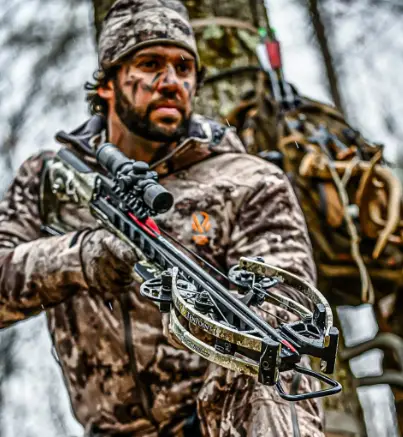Vertical crossbows and horizontal crossbows refer to the orientation of the bow assembly on the weapon system. The main differences are that vertical crossbows position the bow vertically above the stock, while horizontal crossbows position the bow horizontally in front of the stock.
Beyond basic orientation, several other factors differ significantly between vertical and horizontal crossbow models potentially impacting handling, capabilities, and user preferences.
Below we will compare and contrast vertical vs horizontal crossbow configurations detailing how:
- Draw weight direction impacts arrow velocity and aim
- Cocking mechanisms vary between the designs
- Shooting stance and shooter fit changes for each system
- Special scope considerations exist for appropriately sighting in verticals and horizontals
Understanding these key differences allows hunters and target shooting enthusiasts to select the best crossbow format optimizing accuracy potential, convenience, and comfort accommodating their needs and environments.
Explaining Vertical vs Horizontal Crossbow Configurations
First, what exactly constitutes a vertical or horizontal crossbow on a basic parts level? Let’s visually clarify:
Vertical Crossbow

A vertical crossbow features a bow assembly mounted vertically on top of the main stock, positioned perpendicular to the length of the barrel.
The bow string and cables pull directly back above the trigger mechanism. Arrows rest on top of the flight groove, released upwards before arcing downrange.
Horizontal Crossbow

A horizontal crossbow features a bow assembly mounted horizontally in front of the main stock, inline with the barrel direction.
The bow string and cables pull back horizontally from the front. Arrows sit directly in line with the barrel, releasing straight ahead rather than upwards.
Now that the fundamental layout differs are clear for vertical bow over stock compared to horizontal bow in front of stock crossbow builds, let’s examine how this impacts other performance considerations.
Draw Weight Direction Differences
The orientation of the bow significantly affects draw weight leverage and arrow velocity potential between vertical and horizontal crossbow formats.
Vertical Crossbow Draw
On vertical crossbows, drawing the weight feels similar to a vertical bow with the pull direction going straight backwards above the shoulder which most archers are familiar with.
However, unlike vertical bows held sideways requiring muscular strength to counteract torque, vertical crossbow stocks absorb the bow weight downwards effectively adding leverage and stability.
This allows vertical crossbows to utilize stronger draw weights and impart higher arrow speeds compared to most horizontal crossbows. Many vertical models boast 200+ FPS velocities and over 175lb draws rivaling compound bows.
The backwards pulling draw weight also aligns more naturally with our strength direction. Generally most people can pull more weight vertically around shoulder level relative to other angles.
Horizontal Crossbow Draw
Horizontal crossbows arrange the bow in front, changing the draw direction sideways rather than vertically like most standard bows.
While unusual at first, this horizontal pull generates very solid arrow speed and power. However most horizontal crossbow max out around 185 FPS and 150lb draws due to mechanical limitations.
The bow orientation does allow wrist releases and mounted cranks to assist cocking since the pull loads perpendicularly rather than against shoulders. This permits some models to utilize higher draw weights through leverage.
However, the sideways pull may seem awkward those accustomed to vertical bow mechanics. It applies unnatural sidewards torque against our shoulders unused to horizontal resistance.
This gives vertical crossbows a power advantage. But the unique layout does let some specialized horizontal crossbows exploit alternative cocking aids.
Cocking Mechanism Variations
Speaking of cocking, the bow orientation significantly impacts available cocking mechanism options between vertical and horizontal crossbow platforms.
Vertical Crossbow Cocking
Most vertical crossbows feature integrated crank cocking devices. Shooters place feet in attached stirrups while manually turning handles. Internal pulleys mechanically draw and lock the string at full power.
Other assisted methods like cocking ropes allow using main strength pulling vertically to bend the bow limbs back against the stock. Gravity and bodyweight offset the peak draw weight held only briefly before settling into the locked firing latch.
Due to the backwards-facing vertical bow orientation, not many wrist or mounted crank-style cockers work optimally with vertical crossbows. But specialty shoulder stocks allowing compound bow releases aid certain models.
Horizontal Crossbow Cocking
Horizontal crossbows open lots of options for assisted cocking devices given the bow’s front-facing angle. The most common methods utilize compound bow releases or powerful lever cranks requiring less peak strength.
The bow’s sideways angle better accommodates mounted jacking cranks that pull and secure strings using geared teeth rather than bare hands. This allows higher cocking weight capacities despite lower human pull strength limitations.
Wrist/palm cockers attached directly to strings prove effective on many mid-weight horizontal crossbows as well. The bow’s frontal angle points the pull load forward rather than vertically against shoulders.
While verticals utilize body weight and gravity helping bend bows, mechanical leverage suits horizontals allowing hand releases or cranks to overcome substantial resistance.
Shooting Stance and Shooter Fit Comparison
The bow position additionally affects assumed shooting stance and fit comfort.
Let’s see how vertical vs horizontal formats change body positioning:
Vertical Crossbow Shooting Stance

Vertical crossbows mostly emulate rifle shooting form. The stock shoulders like a long gun allowing cheek weld sighting down vertically-mounted scopes.
The natural rifle handling makes transitions from firearms familiar and intuitive for hunters. Forward elbows brace on knees kneeling or off barricades while sustaining rear stock pressure into the shoulder pocket.
Sighting targets simply involves minor cheek alignment to peer through optics without major postural contortions. Gravity automatically drops arrows on-mark.
The narrow forward profile allows easy shooting even in thick brush or confined blinds. Overall form and length mirrors rifles steady in outstretched arms.
Horizontal Crossbow Shooting Stance

Firearm stances don’t directly apply for horizontal crossbows. The bowed front section forces sideways canting across the chest instead of tucking tightly against shoulders.
Most shooters assume a bladed boxing-type stance with dominant side and lead foot forward. Instead of cheek weld, sighting views straight through the optics similar to archery form.
The wider expanded bow profile also proves more unwieldy in dense surroundings compared to narrow vertical format. Arrows launch rather flat from horizontal bows requiring more precise elevation and windage considerations.
While horizontals allow great shooting latitude reducing position constraints, the posture appears somewhat unconventional for traditional marksmen used to rifles or vertical bows.
Special Scope Considerations
Additionally, mounting optics requires distinct approaches between vertical and horizontal crossbow platforms to establish proper sighting.
Vertical Crossbow Scopes
Familiar rifle-style scopes serve vertical crossbows well. Higher mounting offset above barrels suit the weapons’ downwards bolt trajectories at closer ranges under 100 yards.
The optical centerline typically overhangs barrels necessitating shooters precisely cheek weld for accurate viewing through scopes. Vertically oriented reticles and adjustable elevation turrets prove intuitive for many experienced riflers.
Horizontal Crossbow Scopes
Shooting optics prove challenging for horizontals. Side canting prevents direct centerline mounting. And non-angled barrels misalign scopes not accounting for very flat arrow arcs.
To solve this, quality horizontal crossbow-specific scopes feature tilted reticles and turrets matched precisely to arrow ballistics. Specialty mounting rings also correctly baseline scopes suited for the unique sighting geometrics.
Additionally, peep rear sights combined with lower front sight posts assist bare shooting horizontals for hunters preferring simple bead targeting. Vertical models seldom integrate rear sights since cheek weld scopes dominate.
Vertical vs Horizontal Crossbow Advantages
Now that we covered major performance differences from draw weight and firing mechanics to special scope considerations, which format best fits your needs?
Here’s a quick advantages recap of vertical and horizontal crossbow strong suits:
Vertical Crossbow Advantages
- Higher arrow velocity from stronger draws
- Natural vertical bow-like pull motion
- Intuitive riflery shooting form factor
- Effective narrow handling in thick areas
- Simple drop-down bolt trajectories
- Works fine with universal scopes
Horizontal Crossbow Advantages
- Cocking aids compatibility for higher draws
- Uniquely compact bullet-flat trajectories
- Light and short for maneuverability
- Wider bow spread increases stability
- Matched crossbow-specific scope options
- Peep rear sights usable when preferred
Both platforms boast excellent hunting and target potential. Identify models best matching hunting environs and shooting style preferences to determine ideal vertical versus horizontal crossbow fits.
Verdict – Vertical or Horizontal Crossbow For You?
In the end both vertical and horizontal crossbow varieties excel serving distinct user needs and interests.
Hunters wanting conventional rifle handling, generous arrow speeds from robust vertical draws for taking big game at moderate ranges find vertical crossbows intuitive platforms complementing existing skills.
Meanwhile, horizontal crossbows appeal especially towards specialty hobbyists valuing flatter shooting unique designs assisted by cocking lever cranks. Their specialized capabilities suit short-range small game hunting or exotic archery training.
While verticals draw more raw power, horizontals offer unmatched compact maneuverability and specialty scope mounting. Determine final fit based on intended use environment, shooting style, and power requirements.
Either crossbow variety provides accurate, hard-hitting solutions traditional archers transition towards understanding advantages of preset draws and arrow launches. Both deliver unmatched convenience in the field over vertical bow requirements and limitations.
We hope reviewing key performance differences between available vertical vs horizontal crossbow configurations assists selecting your ideal partner joining future adventures! Let electronics and cams handle nuisance cocking and drawing tasks while shooters simply focus downrange.

